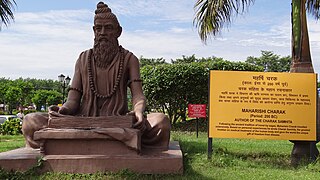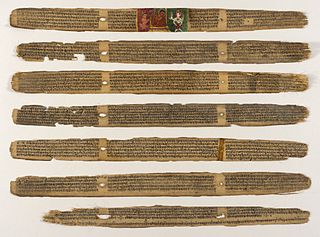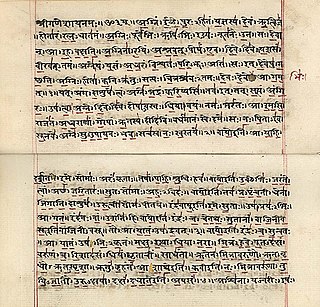Related Research Articles

Patanjali, also called Gonardiya or Gonikaputra, was a Hindu author, mystic and philosopher. Very little is known about him, and while no one knows exactly when he lived; from analysis of his works it is estimated that it was between the 2nd and 4th centuries CE.
Saṃhitā literally means "put together, joined, union", a "collection", and "a methodically, rule-based combination of text or verses". Saṃhitā also refers to the most ancient layer of text in the Vedas, consisting of mantras, hymns, prayers, litanies and benedictions.
Sayana was a Sanskrit Mimamsa scholar from the Vijayanagara Empire of South India, near modern day Bellary. An influential commentator on the Vedas, he flourished under King Bukka Raya I and his successor Harihara II. More than a hundred works are attributed to him, among which are commentaries on nearly all parts of the Vedas. He also wrote on a number of subjects like medicine, morality, music and grammar.

The Yajurveda is the Veda primarily of prose mantras for worship rituals. An ancient Vedic Sanskrit text, it is a compilation of ritual-offering formulas that were said by a priest while an individual performed ritual actions such as those before the yajna fire. Yajurveda is one of the four Vedas, and one of the scriptures of Hinduism. The exact century of Yajurveda's composition is unknown, and estimated by Witzel to be between 1200 and 800 BCE, contemporaneous with Samaveda and Atharvaveda.
Varāhamihira, also called Varāha or Mihira, was an astrologer-astronomer who lived in Ujjain in present-day Madhya Pradesh, India.

The Vedas are a large body of religious texts originating in ancient India. Composed in Vedic Sanskrit, the texts constitute the oldest layer of Sanskrit literature and the oldest scriptures of Hinduism.

The Isha Upanishad is one of the shortest Upanishads, embedded as the final chapter (adhyāya) of the Shukla Yajurveda. It is a Mukhya Upanishad, and is known in two recensions, called Kanva (VSK) and Madhyandina (VSM). The Upanishad is a brief poem, consisting of 17 or 18 verses, depending on the recension.

Pancharatra was a religious movement in Hinduism that originated in late 3rd-century BCE around the ideas of Narayana and the various avatars of Vishnu as their central deities. The movement later merged with the ancient Bhagavata tradition and contributed to the development of Vaishnavism. The Pancharatra movement created numerous literary treatises in Sanskrit called the Pancharatra Samhitas, and these have been influential Agamic texts within the theistic Vaishnava movements.
Utpala or Bhaṭṭotpala is the name of a 10th-century Indian commentator of Vārāha Mihira's Brihat Samhitā. Brihat Samhitā is a Samhitā text of Jyotiṣa. Samhitā is one of three branches of Jyotiṣa.

The Skanda Purana is the largest Mukyapurana, a genre of eighteen Hindu religious texts. The text contains over 81,000 verses, and is of Kaumara literature, titled after Skanda, a son of Shiva and Parvati, who is also known as Murugan. While the text is named after Skanda, he does not feature either more or less prominently in this text than in other Shiva-related Puranas. The text has been an important historical record and influence on the Hindu traditions related to the war-god Skanda.
Agnivesha is a legendary rishi (sage) in Hinduism, reputedly one of the earliest authors on Ayurveda. He is described to have codified the knowledge of his preceptor, Atreya, and arranged it in the form of a treatise, named the Charaka Samhita.

The Charaka Samhita is a Sanskrit text on Ayurveda. Along with the Sushruta Samhita, it is one of the two foundational texts of this field that have survived from ancient India. It is one of the three works that constitute the Brhat Trayi.

The Sushruta Samhita is an ancient Sanskrit text on medicine and surgery, and one of the most important such treatises on this subject to survive from the ancient world. The Compendium of Suśruta is one of the foundational texts of Ayurveda, alongside the Charaka-Saṃhitā, the Bheḷa-Saṃhitā, and the medical portions of the Bower Manuscript. It is one of the two foundational Hindu texts on the medical profession that have survived from ancient India.
The Bṛhat-Trayī, literally translated as "The Great Triad ", refers to three early Sanskrit encyclopaedias of medicine, which are the core texts of the indigenous Indian medical system of Ayurveda. These are contrasted with the Laghu-Trayī or the "lesser triad", a secondary set of later authoritative compositions.

Sushruta, or Suśruta was an ancient Indian physician. The Sushruta Samhita, a treatise ascribed to him, is one of the most important surviving ancient treatises on medicine and is considered a foundational text of Ayurveda. The treatise addresses all aspects of general medicine, but the impressive chapters on surgery have led to the false impression that this is its main topic. The translator G. D. Singhal dubbed Suśruta "the father of surgery" on account of these detailed accounts of surgery.

Atreya (आत्रेय) Rishi, or Atreya Punarvasu, was a descendant of Atri, one of the great Hindu sages (rishis) whose accomplishments are detailed in the Puranas. Sage Atreya was a renowned scholar of Ayurveda, and a school of early Ayurveda was founded based on his teachings.
The Agamas are a collection of several Tantric literature and scriptures of Hindu schools. The term literally means tradition or "that which has come down", and the Agama texts describe cosmology, epistemology, philosophical doctrines, precepts on meditation and practices, four kinds of yoga, mantras, temple construction, deity worship and ways to attain sixfold desires. These canonical texts are in Tamil and Sanskrit. Agamas were predominant in South India but Sanskritized later.

The Rigveda or Rig Veda is an ancient Indian collection of Vedic Sanskrit hymns (sūktas). It is one of the four sacred canonical Hindu texts (śruti) known as the Vedas. Only one Shakha of the many survive today, namely the Śakalya Shakha. Much of the contents contained in the remaining Shakhas are now lost or are not available in the public forum.

Raghuttama Tirtha ; IAST:Śrī Raghūttama Tīrtha), was an Indian philosopher, scholar, theologian and saint. He was also known as Bhavabodhacharya. His diverse oeuvre include commentaries on the works of Madhva and Jayatirtha. He served as the fourteenth pontiff of Madhvacharya Peetha - Uttaradi Math from 1557 to 1595, which he occupied, with remarkable distinction for thirty-nine years. He is considered to be one of the most important seers in the history of Dvaita school of thought. His shrine at Tirukoilur attracts thousands of visitors every year.
Bhela Samhita is a Sanskrit-language medical text from ancient India. It is known from an incomplete c. 1650 CE manuscript kept at the Sarasvati Mahal Library in Thanjavur, and a c. 9th century fragment found at Tuyoq. Quotations in other works suggest that an older version of the text, possibly composed during 400-750 CE, existed.
References
- ↑ Surendranath Dasgupta. A History of Indian Philosophy, Volume 1. Motilal Banarsidass. p. 427.
- P. V. Sharma (1982), Dalhana and his Comments on Drugs, New Delhi, India Munshiram Manoharlal Publishers, ISBN 9788121501590.
- P. V. Sharma (1999), Susruta-Samhita: With English Translation of Text and Dalhana's Commentary Along with Critical Notes, 3 Vols. Vol. I: Sutrasthana, Vol. II: Kalpasthana and Uttaratantra, Vol. III: Nidana, Sarira and Cikitsasthana; Chowkhamba Visvabharati; Varanasi.